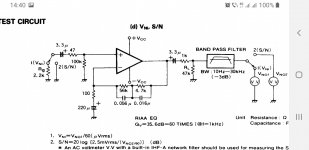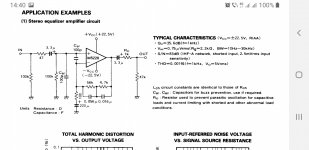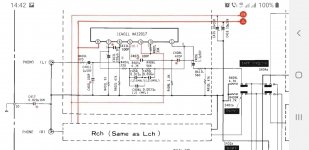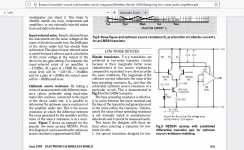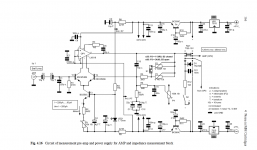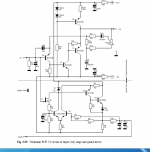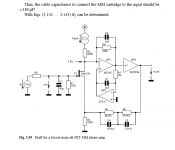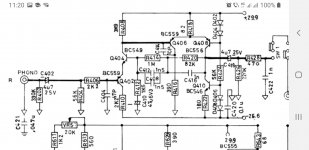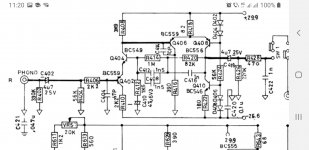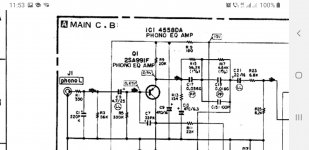Put a buffer on the output and take the EQ network after the buffer. At normal HF input levels, the peak current into the feedback network with a low gain setting resistance (~100 Ohms) and gain of 35 to 40 dB is 1-2 mA. A 5532/4 or OPA1641/2 will easily handle this. At worst case with max HF input just before clipping, the output current approaches 20 mA - but you are highly unlikely to ever encounter signals at this level on a vinyl incl. pops and scratches.
See herd for more info https://hifisonix.com/wordpress/wp-content/uploads/2015/01/RIAA-Equalization-Amplifiers-V2.0.pdf
See herd for more info https://hifisonix.com/wordpress/wp-content/uploads/2015/01/RIAA-Equalization-Amplifiers-V2.0.pdf
If you think your op amp can't drive the riaa network try one of these variations.These op amps were specifically designed for phono preamps one accepting +-22.5v , the other +-25v with same heatsink capability as any other op amp.Basically everyone in the industry used their datasheet as guidance for a decent quality phono preamps.m5220 was preffered to ne5534 in almost all top notch uber expensive cassette players and tells something.Both m5220 and upc4570 were preffered to ne5534 in best Denon and JVC i/v stages .Almost all dj consoles are full of upc 4570, njm2068 and njm4580.
Their datasheet contain true measured phono preamps .m5220, hitachi HA chips and some upc chips were guaranteed for max input of 250mV.For that you need both current capability and output excursion of at least 22.5V.
Their datasheet contain true measured phono preamps .m5220, hitachi HA chips and some upc chips were guaranteed for max input of 250mV.For that you need both current capability and output excursion of at least 22.5V.
Attachments
I think D Self sacrificed many things just fir the noise, if we consider the 600 ohm loading limit for Ne5532, maybe with the higher impedance EQ network there won't be an issue. But I will consider your thoughts on this. Thank you so much.If you think your op amp can't drive the riaa network try one of these variations.These op amps were specifically designed for phono preamps one accepting +-22.5v , the other +-25v with same heatsink capability as any other op amp.Basically everyone in the industry used their datasheet as guidance for a decent quality phono preamps.m5220 was preffered to ne5534 in almost all top notch uber expensive cassette players and tells something.Both m5220 and upc4570 were preffered to ne5534 in best Denon and JVC i/v stages .Almost all dj consoles are full of upc 4570, njm2068 and njm4580.
Their datasheet contain true measured phono preamps .m5220, hitachi HA chips and some upc chips were guaranteed for max input of 250mV.For that you need both current capability and output excursion of at least 22.5V.
download and read this:
https://www.keith-snook.info/wireless-world-magazine/Wireless-World-1989/Designing low-noise audio amplifiers.pdf
this next book has tons of information that barelly any other book on phono covers.
https://pearl-hifi.com/06_Lit_Archive/14_Books_Tech_Papers/Vogel_Burkhard/The Sound of Silence.pdf
Keep in mind that internally and as pinout lm318 is identical to ne534.
I am going soon to build myself a version using lm394 to substitute the input trz of ne5534 to get to the lowest noise possible in bipolar technology at least for curiosity.Ne5534 still allows for pretty high transient outputs and it is better than ne5532 .Lm318 allows for better slew rate, but lower supply voltage than ne5534 so I'd say ne5534 is still better for input stage substitution, but 50v/us is a lot and can deal with any transients while being prone to oscillations if pcb is not drawn correctly.
Ne5534 and lm318 are the only chips I know that allow for the substitution of any of thir 3 internal stages.
https://eu.mouser.com/ProductDetail/Analog-Devices/LT318AN8PBF?qs=hVkxg5c3xu%2BVCH70l%2BTD1g==
Also LM833 was found to be significantly better than ne5534 at common mode distortions by Salas and Cordell if I'm not mistaken.Unfortunately it only allows +-15v supply, but can be used in smart ways to do the job:
https://www.ti.com/lit/an/snoa586d/snoa586d.pdf?ts=1663717641378
https://www.keith-snook.info/wireless-world-magazine/Wireless-World-1989/Designing low-noise audio amplifiers.pdf
this next book has tons of information that barelly any other book on phono covers.
https://pearl-hifi.com/06_Lit_Archive/14_Books_Tech_Papers/Vogel_Burkhard/The Sound of Silence.pdf
Keep in mind that internally and as pinout lm318 is identical to ne534.
I am going soon to build myself a version using lm394 to substitute the input trz of ne5534 to get to the lowest noise possible in bipolar technology at least for curiosity.Ne5534 still allows for pretty high transient outputs and it is better than ne5532 .Lm318 allows for better slew rate, but lower supply voltage than ne5534 so I'd say ne5534 is still better for input stage substitution, but 50v/us is a lot and can deal with any transients while being prone to oscillations if pcb is not drawn correctly.
Ne5534 and lm318 are the only chips I know that allow for the substitution of any of thir 3 internal stages.
https://eu.mouser.com/ProductDetail/Analog-Devices/LT318AN8PBF?qs=hVkxg5c3xu%2BVCH70l%2BTD1g==
Also LM833 was found to be significantly better than ne5534 at common mode distortions by Salas and Cordell if I'm not mistaken.Unfortunately it only allows +-15v supply, but can be used in smart ways to do the job:
https://www.ti.com/lit/an/snoa586d/snoa586d.pdf?ts=1663717641378
Attachments
Last edited:
Thanks for the helpful article, but correct me if I'm wrong, based on the descriptions buffer is added after the EQ network. Are you talking about some other way of approach?Put a buffer on the output and take the EQ network after the buffer. At normal HF input levels, the peak current into the feedback network with a low gain setting resistance (~100 Ohms) and gain of 35 to 40 dB is 1-2 mA. A 5532/4 or OPA1641/2 will easily handle this. At worst case with max HF input just before clipping, the output current approaches 20 mA - but you are highly unlikely to ever encounter signals at this level on a vinyl incl. pops and scratches.
See herd for more info https://hifisonix.com/wordpress/wp-content/uploads/2015/01/RIAA-Equalization-Amplifiers-V2.0.pdf
You have done a lot of help , Im gonna try those op amps instead of NE5532 and see what happens. Thanks buddydownload and read this:
https://www.keith-snook.info/wireless-world-magazine/Wireless-World-1989/Designing low-noise audio amplifiers.pdf
this next book has tons of information that barelly any other book on phono covers.
https://pearl-hifi.com/06_Lit_Archive/14_Books_Tech_Papers/Vogel_Burkhard/The Sound of Silence.pdf
Keep in mind that internally and as pinout lm318 is identical to ne534.
I am going soon to build myself a version using lm394 to substitute the input trz of ne5534 to get to the lowest noise possible in bipolar technology at least for curiosity.Ne5534 still allows for pretty high transient outputs and it is better than ne5532 .Lm318 allows for better slew rate, but lower supply voltage than ne5534 so I'd say ne5534 is still better for input stage substitution, but 50v/us is a lot and can deal with any transients while being prone to oscillations if pcb is not drawn correctly.
Ne5534 and lm318 are the only chips I know that allow for the substitution of any of thir 3 internal stages.
https://eu.mouser.com/ProductDetail/Analog-Devices/LT318AN8PBF?qs=hVkxg5c3xu%2BVCH70l%2BTD1g==
Also LM833 was found to be significantly better than ne5534 at common mode distortions by Salas and Cordell if I'm not mistaken.Unfortunately it only allows +-15v supply, but can be used in smart ways to do the job:
https://www.ti.com/lit/an/snoa586d/snoa586d.pdf?ts=1663717641378
Here are some advanced forms of buffered phono preamplifiers, one using a simple op-amp , others using the most advanced ic's having even their own heatsink, supporting +-30...35v supply thus having the buffer in it.
Now if you really care about every performance attached to a phono preamp you'd need to go fully discreet cause those op-amps like TA2010 aren't anywhere to be found today.Ta2010 was basically an approximation of the core of second, third and buffer stage of the discreete kenwood l-02A .
Now if you really care about every performance attached to a phono preamp you'd need to go fully discreet cause those op-amps like TA2010 aren't anywhere to be found today.Ta2010 was basically an approximation of the core of second, third and buffer stage of the discreete kenwood l-02A .
Attachments
-
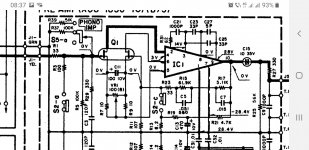 Screenshot_20220922-083739_Word.jpg227.7 KB · Views: 162
Screenshot_20220922-083739_Word.jpg227.7 KB · Views: 162 -
 Screenshot_20220922-083538_Word.jpg211.6 KB · Views: 139
Screenshot_20220922-083538_Word.jpg211.6 KB · Views: 139 -
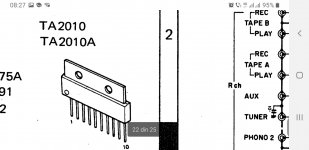 Screenshot_20220922-082737_Word.jpg107.1 KB · Views: 139
Screenshot_20220922-082737_Word.jpg107.1 KB · Views: 139 -
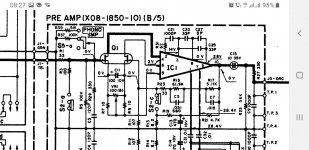 Screenshot_20220922-082719_Word.jpg226.6 KB · Views: 137
Screenshot_20220922-082719_Word.jpg226.6 KB · Views: 137 -
 Screenshot_20220922-081833_Word.jpg204.2 KB · Views: 153
Screenshot_20220922-081833_Word.jpg204.2 KB · Views: 153 -
 Screenshot_20220922-081819_Word.jpg200 KB · Views: 168
Screenshot_20220922-081819_Word.jpg200 KB · Views: 168 -
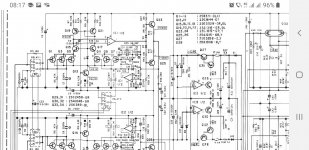 Screenshot_20220922-081749_Word.jpg242 KB · Views: 154
Screenshot_20220922-081749_Word.jpg242 KB · Views: 154 -
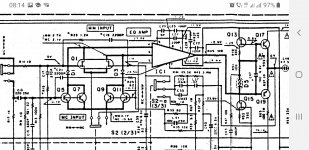 Screenshot_20220922-081500_Word.jpg507.3 KB · Views: 142
Screenshot_20220922-081500_Word.jpg507.3 KB · Views: 142 -
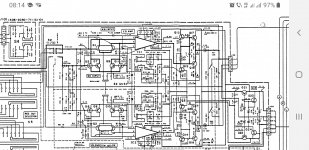 Screenshot_20220922-081417_Word.jpg604.4 KB · Views: 163
Screenshot_20220922-081417_Word.jpg604.4 KB · Views: 163
Although along the lines of technics,kenwood and nakamichi and I'm not sure who coined first this type of mm preamp here's dbx cx-3 mk2 mm phono section and DBX were (as THAT who bought them later is today) the studio standard for level control. There's a catch with some very few units that used 2sk146.2sk146 was a double matched 2sk170 but they came in one flovour that's extinct today and that's 2sk146V ...and taming 2sk146V is a job that kenwood did right because you need to limit its peak current on tranzients and that's kind of impossible with the op amps we have today so aiwa and nakamichi had a simple solution to that even when used with bipolar transistors and voltage feedback.Apparently bipolar inputs are better on transients in voltage feedback designs as their input capacitance is much lower than the one of low noise jfets .I still think APT Holman preamp ( similar to MarcelVDG design ) had something important to say using a bipolar trz for the feedback one when you look at the feedback speed not just on the noise side .It's basically a high gm buffer driving the source of the input trz and that's significantly better than using identical jfet trz. There was a theoretical demonstration of the opposite on Nick Sukhov preamp topic from a pure thd perspective , but I don't agree to it when applied to phono preamps dealing with up to 40db sudden rise in levels when hitting dust or scratches or just having a needle drop on vinyl as it happens from time to time . .Nakamichi in my opinion had the edge over cheap Technics versions with using decoupled dc inputs to the op amp, njm5532 which was reported to measure better than ne5532(somewhat along the lines of njm2114, but higher input impedance if i recall it right...) and also an eliptic subsonic filter and that was a first while APT Holman is wisdom applied to the real world. Audiolab 8000 has also a very interesting bipolar input approach.
Paul Kemble's page was my first introduction 11 years ago to phono preamps history and still is a good place to start: https://www.angelfire.com/sd/paulkemble/sound4.html
Paul Kemble's page was my first introduction 11 years ago to phono preamps history and still is a good place to start: https://www.angelfire.com/sd/paulkemble/sound4.html
Attachments
-
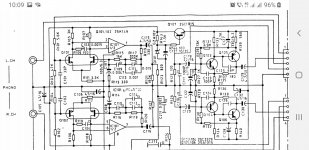 Screenshot_20220922-100914_Word.jpg242.9 KB · Views: 134
Screenshot_20220922-100914_Word.jpg242.9 KB · Views: 134 -
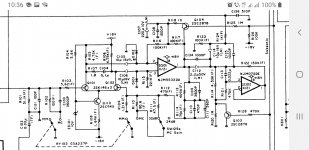 Screenshot_20220922-103651_Word.jpg190.2 KB · Views: 124
Screenshot_20220922-103651_Word.jpg190.2 KB · Views: 124 -
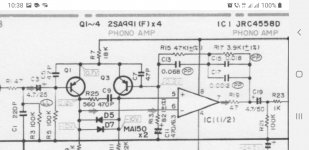 Screenshot_20220922-103813_Word.jpg155.2 KB · Views: 171
Screenshot_20220922-103813_Word.jpg155.2 KB · Views: 171 -
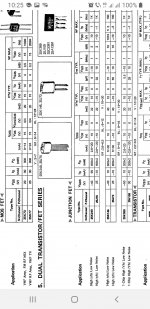 Screenshot_20220922-102600_Word.jpg238.4 KB · Views: 145
Screenshot_20220922-102600_Word.jpg238.4 KB · Views: 145 -
 Screenshot_20220922-110404_Samsung Internet.jpg180.1 KB · Views: 177
Screenshot_20220922-110404_Samsung Internet.jpg180.1 KB · Views: 177
Last edited:
You put the buffer after the opamp and then take the RIAA feedback from the output of the buffer. There are circuits in the document I linked to.Thanks for the helpful article, but correct me if I'm wrong, based on the descriptions buffer is added after the EQ network. Are you talking about some other way of approach?
Buffering a gain stage(discreet) was never done better than in nad3020 which is probably the smartest phono preamp ever made anyway...the feedback driving the cascode instead of the input transistor makes sure no tranzients will get over.You get tons of reviews and talks over it, just a tiny example here: https://www.diyaudio.com/community/threads/nad-3020-as-separate-phono-stage.353281/
What driving the input transistor get more is just an unnecessary thd improvement of the reproduction of a medium that has 1000x higher distortions than a typical low noise op amp..so there's no real point in it. Replacing the transistors with lower noise ones will probably send this preamp straight to heaven.
What driving the input transistor get more is just an unnecessary thd improvement of the reproduction of a medium that has 1000x higher distortions than a typical low noise op amp..so there's no real point in it. Replacing the transistors with lower noise ones will probably send this preamp straight to heaven.
Attachments
Now if you look carefully on both these next schematics you'll see the same trick done with splitting the input 47k loading into same two resistors, but a very big difference in the collector current and base current bias .Aiwa c22 using a very low noise trz at around 700uA collector current and a high input bias resistor, while the NAD has around 100uA collector current working in the first stage, but the 56k input bias resistor instead of the 330k which is kind of illogical and I suspect the true value of the input bias resistor to be Aiwa's value.Besides bc550/bc459 aren't doing too great in terms of noise bellow 1mA so I'm not sure why they chose such a low current but in those times large batches of transistors were manually handled for lower noise transistorsselection...Now this preamp has pretty high rail voltages so no hard clipping is gonna be expected.Probably mods are done to it too, but my first mod would be just to reverse the two resistors having 330k bias resistor and 56 k input resistor .The wole gain structure might be accomodated to lower noise transistors, but that need extensive simulations and NAD engineers were no beginnersand I'm not too comfortable saying I might be able to improve their design if at all...
Never listened to Nad, but did it to aiwa c-22 supplied at +-15v and that was the first solid state experience that approached tubes on transients.
Never listened to Nad, but did it to aiwa c-22 supplied at +-15v and that was the first solid state experience that approached tubes on transients.
Attachments
I got it, thank you.You put the buffer after the opamp and then take the RIAA feedback from the output of the buffer. There are circuits in the document I linked to.
The trick with solid state phono amps, and especially ones using opamps if that's what floats your boat, is to go 'all-active'. On +-15V rails, +30 dB O/L margin ref 5mV at 1 kHz is quite achievable and it holds across the entire audio band. As a side benefit, you also get very good noise performance and lower distortion. Passive EQ or semi-passive EQ topologies always trade noise and/or O/L margin. The same applies to discrete solid state RIAA EQ amp (see the 'Bonsai' in the document I linked to earlier). Douglas Self discusses this in his books and although I don't agree with all his pronouncements, he is spot on wrt all active RIAA feedback.
Passive makes more sense for tube based designs because you have enormous head room thanks to the very high supply voltages, but I have not seen any tube based design that will trump a well design solid state EQ preamp wrt noise.
Passive makes more sense for tube based designs because you have enormous head room thanks to the very high supply voltages, but I have not seen any tube based design that will trump a well design solid state EQ preamp wrt noise.
This is active: huge dynamics..can work with 10V rms input signal without entering hard clipping .I cloned it removing the dc offset comp stage.You hear every single hair of dust on the record at huge levels, but nothing harsh probably due to natural compression effect of ecc83.You can't get similar behavior with high GM low noise tubes in active feedback because of their higher slew rate.Passive makes more sense for tube based designs because you have enormous head room thanks to the very high supply voltages, but I have not seen any tube based design that will trump a well design solid state EQ preamp wrt noise.
You can't imagine the sensation until you hear it:
http://www.thevintageknob.org/luxman-CL-34.html
I just re-designed the circuit in Multisim added the buffer between the op-amp output and riaa network. Should re design the PCB soon. I will send some photos then. Again, thanks alot,The trick with solid state phono amps, and especially ones using opamps if that's what floats your boat, is to go 'all-active'. On +-15V rails, +30 dB O/L margin ref 5mV at 1 kHz is quite achievable and it holds across the entire audio band. As a side benefit, you also get very good noise performance and lower distortion. Passive EQ or semi-passive EQ topologies always trade noise and/or O/L margin. The same applies to discrete solid state RIAA EQ amp (see the 'Bonsai' in the document I linked to earlier). Douglas Self discusses this in his books and although I don't agree with all his pronouncements, he is spot on wrt all active RIAA feedback.
Passive makes more sense for tube based designs because you have enormous head room thanks to the very high supply voltages, but I have not seen any tube based design that will trump a well design solid state EQ preamp wrt noise.
Cheers.
I just re-designed the circuit in Multisim added the buffer between the op-amp output and riaa network. Should re design the PCB soon. I will send some photos then. Again, thanks alot,This is active: huge dynamics..can work with 10V rms input signal without entering hard clipping .I cloned it removing the dc offset comp stage.You hear every single hair of dust on the record at huge levels, but nothing harsh probably due to natural compression effect of ecc83.You can't get similar behavior with high GM low noise tubes in active feedback because of their higher slew rate.
You can't imagine the sensation until you hear it:
http://www.thevintageknob.org/luxman-CL-34.html
Cheers.
This is the SNR comparison of few op-amps suitable for MM input stage done by D Self. As you see the NE5534 with R0 = 220 ohm has the best SNR amongst others. Even with R0 = 1k the noise is not an issue and SNR is about 1dB less than the ideal figure. I guess it is safe to calculate the EQ network based on 1k ohm R0?
Yes. For the money (about 40c if you shop around) the NE5534A is still the best solution out there.
Note, his figures IIRC are for a shorted input and spot noise at 1 kHz and not with a real MM source.
You can use the spread sheet in the link here to calculate the real SNR
https://hifisonix.com/so-just-how-quiet-is-your-phono-stage/
Note, his figures IIRC are for a shorted input and spot noise at 1 kHz and not with a real MM source.
You can use the spread sheet in the link here to calculate the real SNR
https://hifisonix.com/so-just-how-quiet-is-your-phono-stage/
- Home
- Source & Line
- Analogue Source
- Advise needed on a phono preamp (occasional harshness in high frequency range)
